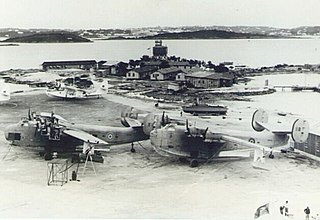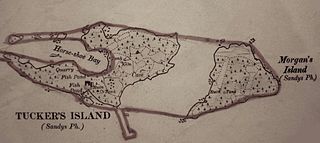
Bermuda is a British Overseas Territory in the North Atlantic Ocean. It is approximately 1,035.26 km (643 mi) east-southeast of Cape Hatteras, North Carolina ; 1,236 km (768 mi) south of Cape Sable Island, Nova Scotia; 1,759 km (1,093 mi) northeast of Cuba, and 1,538 km (956 mi) due north of the British Virgin Islands. Though it is typically referred to in the singular, Bermuda consists of 181 islands; the largest of these islands is known as Main Island. The capital city of Bermuda is Hamilton. Bermuda is internally self-governing, with its own constitution and cabinet of ministers selected from the elected Members of the lower house of a Parliament that enacts local laws. As the national government, the Government of the United Kingdom is ultimately responsible for ensuring good governance within British Overseas Territories, and retains responsibility for defence and foreign relations. As of July 2018, it has a population of 71,176, making it the most populous of the British overseas territories.

Bermuda was originally discovered in 1503 by Spanish explorer Juan de Bermúdez. In 1609, the English Virginia Company, which had established Jamestown in Virginia two years earlier, permanently settled Bermuda in the aftermath of a hurricane, when the crew and passengers of Sea Venture steered the ship onto the surrounding reef to prevent it from sinking, then landed ashore. Bermuda's first capital, St. George's, was established in 1612.

The defence of Bermuda remains the responsibility of the United Kingdom Government, rather than of the local Bermudian Government. Despite this, the Bermuda Government was historically responsible for maintaining Militia for the defence of the Colony.
The destroyers-for-bases deal was an agreement between the United States and the United Kingdom on September 2, 1940, according to which 50 Caldwell, Wickes, and Clemson class US Navy destroyers were transferred to the Royal Navy from the United States Navy in exchange for land rights on British possessions.

Kindley Air Force Base was a United States Air Force base in Bermuda from 1948–1970, having been operated from 1943 to 1948 by the United States Army Air Forces as Kindley Field.

Warwick Parish is one of the nine parishes of Bermuda. It is named after Robert Rich, 2nd Earl of Warwick (1587-1658).

Ireland Island is the northwesternmost island in the chain which comprises Bermuda. It forms a long finger of land pointing northeastwards from the main island, the last link in a chain which also includes Boaz Island and Somerset Island. It lies within Sandys Parish, and forms the northwestern coast of the Great Sound. it is regarded as one of the six principal islands of Bermuda.

Boaz Island, formerly known as Gate's Island or Yates Island, is one of the six main islands of Bermuda. It is part of a chain of islands in the west of the country that make up Sandys Parish, lying between the larger Ireland Island and Watford Island, with which it has been joined by a man-made isthmus. South of Watford Island is Somerset Island. Boaz and Watford are connected to Somerset by Watford Bridge, and to Ireland by Gray's Bridge. Watford's east coast forms part of the edge of the Great Sound. The western end of the channel between Boaz and Watford was blocked by the isthmus, creating a camber that opens to the Great Sound. Boaz and Watford Islands were parts of the Royal Naval base, which included the HM Dockyard on Ireland Island.

HMD Bermuda was the principal base of the Royal Navy in the Western Atlantic between American independence and the Cold War. Bermuda had occupied a useful position astride the homeward leg taken by many European vessels from the New World since before its settlement by England in 1609. French privateers may have used the islands as a staging place for operations against Spanish galleons in the 16th century. Bermudian privateers certainly played a role in many Imperial wars following settlement. Despite this, it was not until the loss of bases on most of the North American Atlantic seaboard threatened Britain's supremacy in the Western Atlantic that the island assumed great importance as a naval base. In 1818 the Royal Naval Dockyard, Bermuda officially replaced the Royal Naval Dockyard, Halifax as the British headquarters for the North America and West Indies Station.

The United States Navy's Naval Operating Base was a seaplane base in Bermuda, the original U S Naval Air Station Bermuda. Following the US Navy's takeover of Kindley Air Force Base, the base was adapted to other uses as an annex to the new USNAS Bermuda, the NAS Annex. Following the end of the Cold War, the base was closed in 1995, along with other US Naval, Royal Naval, and Canadian Armed Forces facilities in Bermuda. At one point, the disused seaplane base/Annex was to be redeveloped into a golf course.

RNAS Bermuda was a Royal Naval Air Station on Boaz Island, Bermuda. The station became the primary base for the Royal Navy in the North-West Atlantic following American independence. It was the location of a dockyard, an Admiralty House, and the base of a naval squadron.

The Royal Air Force (RAF) operated from two locations in Bermuda during the Second World War. Bermuda's location had made it an important naval station since US independence, and, with the advent of the aeroplane, had made it as important to trans-Atlantic aviation in the decades before the Jet Age. The limited, hilly land mass had prevented the construction of an airfield, but, with most large airliners in the 1930s being flying boats, this was not initially a limitation.

Agar's Island is an island of Bermuda. Located in the Great Sound, near to the shore of the parish of Pembroke, it was owned by billionaire James Martin, and was historically a secret munitions store, part of the Bermuda Garrison of the British Army.

Morgan's Island was an island of the British Overseas Territory of Bermuda. It was part of the land leased to the United States Government in 1941 for ninety-nine years for the construction of the Naval Operating Base Bermuda, a joint shipping base and naval air station. Morgan's Island was joined by infilling to nearby Tucker's Island, and the two were connected to the Main Island by a narrow infilling, creating a peninsula. The base, by then designated the Naval Air Station Bermuda Annex, was closed in 1995 along with other US bases in Bermuda. After a delay while the issue of toxic waste deposits was argued between the British/Bermudian and US Governments, the land was handed back to the Government of Bermuda and allowed to return to nature pending the clean-up of toxins and a decision on its future. The only user of the area was the Royal Bermuda Regiment, which had begun training there when it was still a US base. Following public outrage at plans to develop a Jumeirah resort hotel at Southlands, then a wooded private estate on the South Shore, the government traded the former US naval base to the developers in exchange for Southlands, most of which was designated as parkland. Morgan's Point, as the former naval base is now called, is currently being cleared to make way for the new resort.

The Bermuda Flying School operated on Darrell's Island from 1940 to 1942. It trained Bermudian volunteers as pilots for the Royal Air Force and the Fleet Air Arm.

The United States Naval Station Whites Island was a United States Navy (USN) facility located on White's Island in Hamilton Harbour, in the British Colony of Bermuda, 640 miles off the coast of North Carolina.

The Bermuda Base Command was a command of the United States Army, established to defend the British Colony of Bermuda, located 640 miles off Cape Hatteras, North Carolina. It was created in April 1941 when United States Army troops were sent to the island.

HMS Castle Harbour was a civilian harbour vessel of 730 tons that was taken-up from trade (TUFT) during the Second World War by the Royal Naval Dockyard in Bermuda for use by the Royal Naval Examination Service and later armed and commissioned as a warship, providing harbour defence from submarines.

Tucker's Island was an island of the British Overseas Territory of Bermuda. It was part of the land leased to the United States Government in 1941 for ninety-nine years for the construction of the Naval Operating Base Bermuda, a joint shipping base and naval air station. Tucker's Island was joined by infilling to nearby Morgan's Island, and the two were connected to the Main Island by a narrow infilling, creating a peninsula. The base, by then designated the Naval Air Station Bermuda Annex, was closed in 1995 along with other US bases in Bermuda. After a delay while the issue of toxic waste deposits was argued between the British/Bermudian and US Governments, the land was handed back to the Government of Bermuda and allowed to return to nature pending the clean-up of toxins and a decision on its future. The only user of the area was the Royal Bermuda Regiment, which had begun training there when it was still a US base. Following public outrage at plans to develop a Jumeirah resort hotel at Southlands, then a wooded private estate on the South Shore, the government traded the former US naval base to the developers in exchange for Southlands, most of which was designated as parkland. Morgan's Point, as the former naval base is now called, is currently being cleared to make way for the new resort.

















